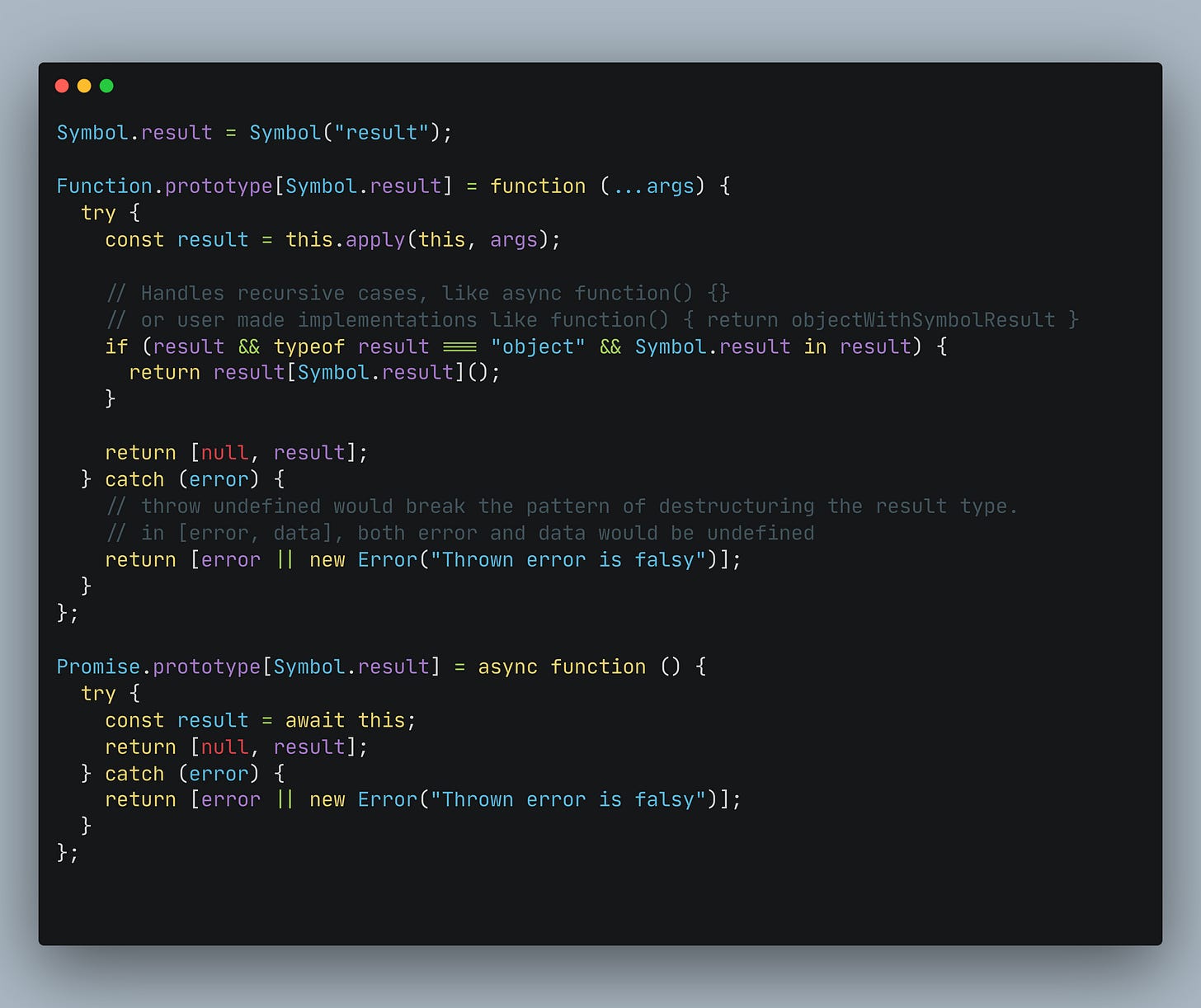Goodbye try...catch? Meet the New ?= Operator in JavaScript
Meet the Safe Assignment Operator ?=, simplifying JavaScript with smarter error handling and cleaner code.
In JavaScript, we use try...catch to handle errors. When you write code, sometimes things go wrong. For example, you might try to fetch data from a website, but the website is down. This is where try...catch helps. It catches errors and lets you handle them without crashing your program.
Traditional Error Handling Example
Let's look at a simple example of how try...catch works:
In this example:
try is used to run code that might throw an error.
await fetch("https://bytelily.substack.com/") tries to get data from a website.
If it works, it prints the data.
If it fails, catch (error) catches the error and prints an error message.
Limitations of Traditional try...catch
While try...catch is useful, it has some limitations:
Cluttered Code: It can make your code look messy, especially if you have many try...catch blocks.
Nested Blocks: When you have nested try...catch blocks, it becomes hard to read and understand.
Repetitive: You might find yourself writing the same error handling code over and over.
Because of these limitations, developers are looking for simpler ways to handle errors. This leads us to the new proposal: the Safe Assignment Operator ?=.
Overview of the Safe Assignment Operator ?=
The goal of the Safe Assignment Operator ?= is to make error handling easier. It does this by turning the result of a function into an array to handle errors. If the function throws an error, the operator returns [error, null]. If the function runs successfully, it returns [null, result]. This operator works with Promises, async functions, and any value that implements the Symbol.result method.
For example, when doing I/O operations or working with Promise-based APIs, unexpected errors can happen. Ignoring these errors can cause unwanted behavior and potential security issues. Using the Safe Assignment Operator can handle these errors effectively:
Motivation for the Proposal
Simplify Error Handling: By getting rid of try...catch blocks, it simplifies the error management process.
Enhance Code Readability: It reduces nesting and makes the code clearer, making the error handling flow more straightforward.
Consistency Across APIs: It provides a unified way to handle errors across different APIs, ensuring consistent behavior.
Improve Security: It reduces the risk of ignoring error handling, thereby enhancing overall code security.
Usage Example
Here's a typical example of error handling without using the ?= operator:
In this function, there are several points where errors can occur (e.g., fetch(), json(), parse()). We can handle these errors in a much cleaner and more readable way using the ?= operator:
In this example, the ?= operator simplifies the error handling process. It makes the code cleaner and easier to read. The operator helps catch errors at each step and handle them appropriately.
Using ?= with Promises
Besides functions, Promises are the only other implementation that can be used with the ?= operator. Here is an example:
In this example, the ?= operator is used to handle the result of a Promise. If the Promise is rejected, error will contain the error and data will be null. If the Promise is resolved, error will be null and data will contain the result.
How the Proposal Works
The Safe Assignment Operator ?= is still in its early stages. It aims to make error handling easier by turning the result of a function or a Promise into an array. If there is an error, it returns [error, null]. If it works, it returns [null, result].
This operator helps to catch errors and handle them without using try...catch. It works with functions, Promises, and any value that has a Symbol.result method.
Since this proposal is not yet a standard, you might need a way to use it in your code right now. You can use a polyfill to do this. A polyfill is like a piece of code that adds the new feature to older JavaScript environments.
Here is a polyfill you can use: polyfill.js
However, the ?= operator itself cannot be directly polyfilled. For older JavaScript environments, you need a compiler to change the ?= operator into the corresponding [Symbol.result] calls.
Using Radash tryit Method Instead of Polyfill
If you don't want to use the polyfill, you can use Radash's tryit method to handle errors in a similar way. The tryit method catches errors and returns them along with the result, just like the proposed ?= operator.
Here’s how you can use Radash's tryit method:
Install Radash:
First, you need to install Radash in your project. You can do this using npm:Use Radash tryit Method:
Attention
This is only a draft proposal that hasn't even been accepted for consideration yet, let alone adoption. The keyword for safe assignment is still under discussion and subject to change. You can follow the progress and get more details on the proposal here.
Keep an eye on the latest proposals and updates to stay ahead in the world of JavaScript development.
What do you think about this proposal? Feel free to leave your comments below!













